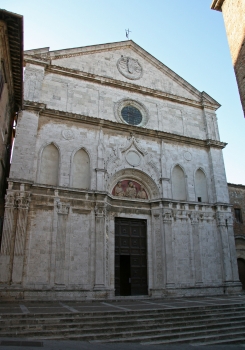|
Our GPS made finding our way out of Todi a breeze, but finding our hotel in Montepulciano turned out to be a challenge.
Most of the roads in Montepulciano are one way.
After passing our hotel the first time, we planned more carefully on our second loop through the city.
We parked upstream of the hotel in a small lot and walked a few blocks to the hotel.
We were staying at the Mueble il Riccio, and our room had a beautiful view (left) of Montepulciano. This hilltown is known
for its Vino Nobile de Montepulciano, which wine
connoisseurs consider among Italy's best.
Our hotel was near the
Piazza Grande, and on our way out to dinner that night we snapped this picture of the Duomo and Palazzo Comunale (right).
We were using Montepulciano as our base to explore the beautiful Tuscan countryside (left). Driving through the countryside,
we saw Montalcino in the distance (right). One of its wines,
Brunello di Montalcino, is even more famous than Montepulciano's.
On our first day in Montepulciano we drove out to see the Abbazia di Sant'Antimo.
This abbey traces its roots to the 4th century A.D. Construction of the current structure began in the 12th century.
When planning our trip, we had considered going to the Abbazia di Monte Oliveto Maggiore after the Abbazia di Sant'Antimo.
Since this would be our only chance to see
Siena on this trip, we decided one abbey would have to be enough this time.
After parking outside Siena, we made our way to its famous shell shaped Piazza del Campo (top-right).
We sat there eating our lunch (pizza), entertained by the people and animals in the piazza.
The Palazzo Pubblico (top-left) is a main feature in the piazza. This town hall's construction began
in 1297, when it was built to house the city's republican government. We didn't have time to go inside, because we wanted to make sure we saw Siena's famous Duomo.
Siena's Duomo was built in the 13th century and is decorated inside and out with stripes of white and dark-green marble. The church is filled
with beautiful and historic art from the likes of Michelangelo, Donatello, and Bernini. We parked at a garage on the Via Baldassarere
Peruzzi near the Church of San Francesco (bottom-right) on the west side of Siena and used a system of underground moving sidewalks and escalators to get into
and out of the city.


Back in Montelpulciano we tried to go to the Consorzio del Vino Nobile di Montepulciano (a trade group of the local wineries)
for a wine tasting, but it had unexpectedly closed early that day. Instead we went to the Contucci winery, which was just around the corner.
We had seen this winery on an episode of Rick Steves' Europe, and when we took out our RS phrase book, the owner started
pointing to the book and telling us about when he met Rick Steves.
After purchasing a bottle to take back home22 with us, we walked around Montepulciano until dusk. Sant'Agostino (left) has a
wooden crucifix by Donatello over the high altar.
San Gimignano was on the way from Montepulciano to Florence, and we had heard so much about its towers. We wanted to make sure
we didn't miss it. Fourteen medieval towers still stand in San Gimignano, although at one time more than 70 rose above the city.
We climbed to the top of the Torre Grossa (Big Tower), finished in 1311, where we had amazing views of the city and rolling Tuscan countryside.
After the Torre Grossa, we headed to the Rocca (not pictured), the remains of the city's 14th century fortress. Although our Frommer's guide said
we should be able to "climb atop the crumbling ramparts for a view", we couldn't find a way up that wasn't blocked off. We did however
get this nice close-up of an olive tree (bottom-right).
San Gimignano was our last stop before dropping our rental car off in Florence.
| 
